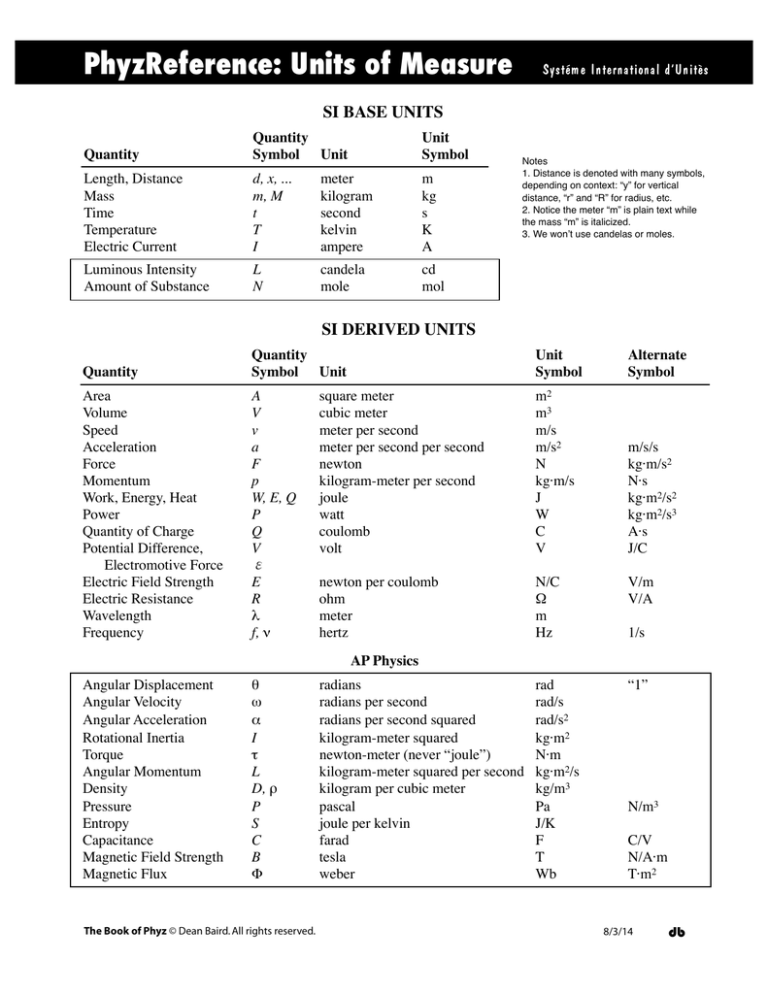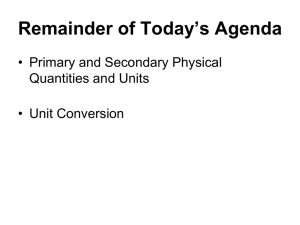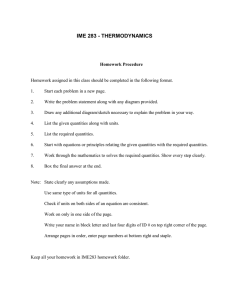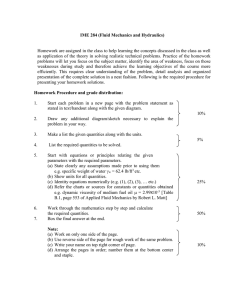
PhyzReference: Units of Measure
Systéme International d‘Unitès
SI BASE UNITS
Quantity
Quantity
Symbol
Unit
Unit
Symbol
Length, Distance
Mass
Time
Temperature
Electric Current
d, x, ...
m, M
t
T
I
meter
kilogram
second
kelvin
ampere
m
kg
s
K
A
L
N
candela
mole
cd
mol
Luminous Intensity
Amount of Substance
Notes
1. Distance is denoted with many symbols,
depending on context: “y” for vertical
distance, “r” and “R” for radius, etc.
2. Notice the meter “m” is plain text while
the mass “m” is italicized.
3. We won’t use candelas or moles.
SI DERIVED UNITS
Quantity
Area
Volume
Speed
Acceleration
Force
Momentum
Work, Energy, Heat
Power
Quantity of Charge
Potential Difference, Electromotive Force
Electric Field Strength
Electric Resistance
Wavelength
Frequency
Quantity
Symbol
Unit
A
V
v
a
F
p
W, E, Q
P
Q
V
ε
E
R
λ
f, ν
Unit
Symbol
Alternate
Symbol
square meter
cubic meter
meter per second
meter per second per second
newton
kilogram-meter per second
joule
watt
coulomb
volt
m2
m3
m/s
m/s2
N
kg·m/s
J
W
C
V
m/s/s
kg·m/s2
N·s
kg·m2/s2
kg·m2/s3
A·s
J/C
newton per coulomb
ohm
meter
hertz
N/C
ΩΩ
m
Hz
V/m
V/A
1/s
AP Physics
Angular Displacement
Angular Velocity
Angular Acceleration
Rotational Inertia
Torque
Angular Momentum
Density
Pressure
Entropy
Capacitance
Magnetic Field Strength
Magnetic Flux
θ
ω
α
I
τ
L
D, ρ
P
S
C
B
Φ
The Book of Phyz © Dean Baird. All rights reserved.
radians
radians per second
radians per second squared
kilogram-meter squared
newton-meter (never “joule”)
kilogram-meter squared per second
kilogram per cubic meter
pascal
joule per kelvin
farad
tesla
weber
rad
rad/s
rad/s2
kg·m2
N·m
kg·m2/s
kg/m3
Pa
J/K
F
T
Wb
“1”
N/m3
C/V
N/A·m
T·m2
8/3/14
db
PhyzReference: Physical Quantities vs. Units
A common difficulty of an Intro Phyz student is distinguishing between physical
quantities and units of measure. Physical quantities are any of the characteristics of
objects or events in nature that can be measured.
A book, for example, is an object with several quantifiable characteristics. Its
dimensions can be measured; these measurements involve the physical quantity of
length. Other physical quantities can also be measured: Its mass can be measured, its
weight can be measured, its volume can be measured, its temperature can be measured,
etc.
If these physical quantities are to be measured, they must be measured in specific units
of measure. Units of measure are the basic standards of measurement, such as miles,
pounds, ounces, etc. Different physical quantities are measured in different units of
measure. It is important that you distinguish between physical quantities and units of
measure—they have separate meanings and functions!
Below is a table of physical quantities and some examples of the units they can be
measured in.
Quantity
Symbol
Units and Abbreviations
Length
x
meters (m), feet (ft), yards (yd), miles (mi), light-years (ly), pipés
Weight
W
newtons (N), pounds (lb), ounces (oz), stones
Mass
m
kilograms (kg), slugs
Time
t
seconds (s), minutes (min), hours (hr), days (dy), weeks (wk), months
(mo), years (yr), decades, scores, centuries, millenia, eons
So the physical quantity of length can be measured in many units (meters, yards,
parsecs, etc.). Formulas in science are written in terms of physical quantities. Formulas
are never written in terms of units. The formula for velocity is v = d/t and is never
expressed as v = m/s or v = mi/hr. If you can’t distinguish between quantities and units,
you could run into confusion when dealing with formulas. Consider the relation for
density:
D=
m
V
If you’re on top of the quantity/unit distinction, then you have no problem: D is density,
m is mass, V is volume. If you can’t distinguish between units and quantities, you might
decide that m is meters and thus density is length/volume instead of mass/volume.
The Book of Phyz © Dean Baird. All rights reserved.
db







